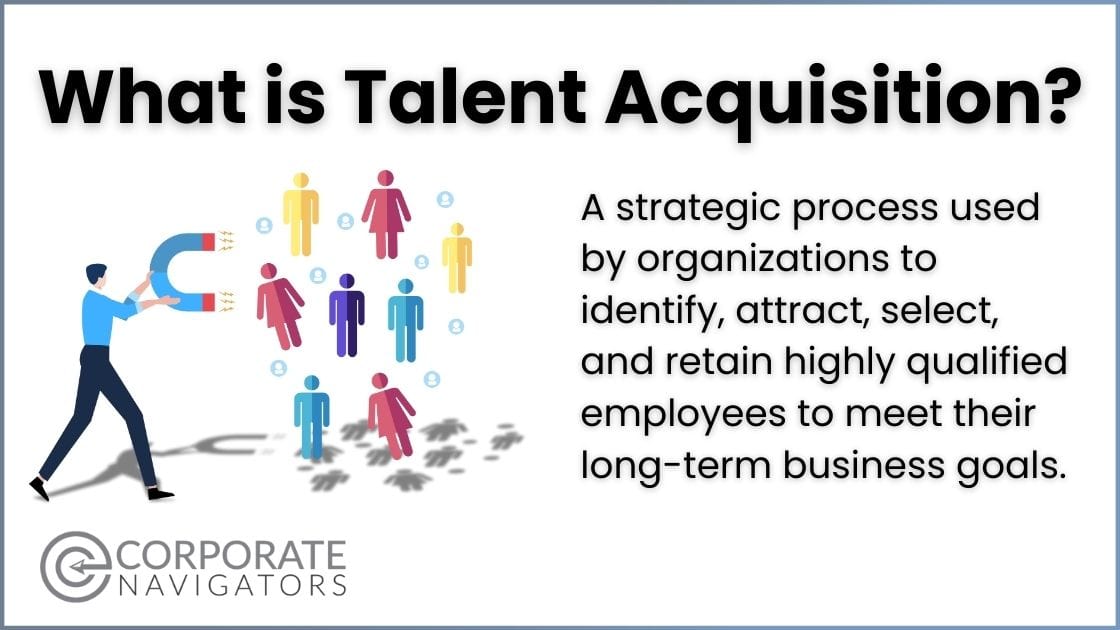
Table of Contents
What is Talent Acquisition?
Talent Acquisition (TA) is a strategic process used by organizations to identify, attract, select, and retain highly qualified employees to meet their long-term business goals. It goes beyond traditional recruitment by building relationships with potential candidates and developing a talent pipeline for future organizational needs.
At Corporate Navigators, we cover the full cycle of talent acquisition through two key services: recruiting research, in which we identify qualified candidates, and candidate sourcing, in which we contact candidates to screen for interest and other factors our clients request.
Key Components of Talent Acquisition:
- Strategic Approach: It’s a long-term strategy that aligns with an organization’s overall goals and involves workforce planning. It’s not a one-and-done job but requires continuous effort and consideration.
- Employer Branding: To attract the talent you want, you need to be a company candidates want to work for. Developing a strong employer brand positions you to attract top talent and showcase the company as a desirable workplace.
- Talent Pipeline Building: Also known as a candidate pipeline, this process involves continuously building a pool of potential candidates for future positions, often before they become available.
- Candidate Experience: Providing a positive experience for candidates throughout the hiring process to enhance the company’s reputation and make it easier to attract talented candidates for onboarding.
- Legal Compliance: With so many moving parts, it’s important to make sure you’re always in compliance. Hire legal help to ensure all hiring practices comply with local, state, and federal laws to maintain fairness and equity.

Why is Talent Acquisition Important?
This process is crucial for companies because it directly impacts business performance. By ensuring the right people are in the right roles, organizations simply run better. In the long run, effective talent acquisition strategies lead to improved productivity, reduced turnover rates, and an enhanced company culture, all of which contribute to a more engaged and motivated workforce.
By attracting top talent, companies can foster innovation, improve customer service, and gain a competitive edge, ultimately boosting business performance and driving sustainable growth. A strategic approach to talent acquisition also helps build diverse and inclusive teams, streamline the hiring process, and reduce recruitment costs.
Talent Acquisition vs. Recruitment:
- Recruitment is a more tactical process focused on filling immediate vacancies efficiently. It usually refers to a short-term goal that is a one-time deal. This can be ideal for occasional hiring needs that are last-minute and urgent.
- TA is a strategic process that considers long-term needs and cultural fit, aiming to build a strong workforce for future success. It has a company’s future talent needs in mind, often incorporating talent pipelines and building candidate relationships to prepare for future role openings.
Overall, talent acquisition is a comprehensive approach to hiring that emphasizes long-term planning, relationship-building, and strategic alignment with organizational goals.
What are the key strategies in TA?
- Developing a strong employer brand: Did you know that 95% of Gen Z checks a company’s brand reputation before deciding to work for them? This makes a solid brand reputation a must in the future of talent acquisition. Create a compelling image of your organization as an attractive workplace to draw in top talent.
- Implementing strategic sourcing: Use targeted sourcing channels to connect with a wider pool of potential candidates, including job boards, social media, and employee referrals. Hiring Corporate Navigators to source candidates and call into companies for even more information will provide even more candidate options.
- Leveraging technology: Technology can save you a lot of time with the basic tasks of recruiting that used to take up a lot of time, such as screening resumes, online profiles, and more. Utilize applicant tracking systems (ATS), AI-powered tools, and other recruitment technologies to streamline the hiring process and improve efficiency.
- Focusing on the candidate journey: An excellent candidate journey is critical to retaining candidates in the application/screening process and after they are hired. To do so, provide a positive experience for candidates throughout the hiring process, including clear communication, timely feedback, and a user-friendly application process.
- Use data-driven insights: With feedback, you can continue to improve on your practices. Employ analytics to make informed decisions, optimize recruitment processes, and improve the quality of hires. Review periodically to see what is effective and what you need to change in your strategy.
- Prioritizing diversity, equity, and inclusion (DEI): To Gen Z, the most diverse generation yet, diversity and inclusion are strong motivators to join a company. This means that using DEI initiatives to build diverse teams can lead to more candidate choices.
- Building talent pipelines: Develop relationships with potential candidates for future positions, even before they become available. Also known as candidate pipelines, this list of candidates is already vetted for their qualifications and interests, saving you time when a job posting opens.
- Personalizing outreach: In the talent acquisition process, engage prospects with personalized messaging to increase the effectiveness of recruitment efforts. This helps your talent pool feeling connected and valued.
- Collaborating internally: A great recruitment strategy doesn’t just focus on external hiring. Plenty of talent can be found within your company through upskilling or reskilling employees into different departments. In this way, you can work with various stakeholders, including hiring managers and team members, to identify the people internally who have the right skills and cultural fit for open positions.
These strategies collectively form a comprehensive approach to talent acquisition, focusing on long-term organizational success rather than simply filling immediate vacancies.
What is talent acquisition?
Talent acquisition is a vital strategic process that goes far beyond traditional recruitment methods. It is the cornerstone of building a successful, innovative, and competitive organization in today’s dynamic business landscape. By implementing comprehensive talent acquisition strategies, companies can not only fill immediate vacancies but also create a robust pipeline of skilled professionals aligned with their long-term goals.
The benefits of effective talent acquisition are manifold, ranging from improved productivity and reduced turnover to enhanced company culture and increased innovation capabilities. As organizations continue to evolve in an increasingly competitive market, mastering the art of talent acquisition will be crucial for sustainable growth and maintaining a competitive edge.
By investing in talent acquisition, companies are essentially investing in their future, ensuring they have the right people in the right roles to drive success and achieve their strategic objectives.


